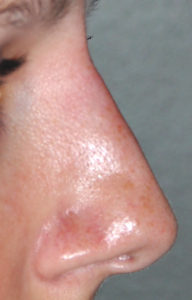The use of injectable fillers has a wide variety of aesthetic uses throughout the face. They provide a non-surgical approach to facial augmentation and in some cases are a good substitute for surgery, albeit often on a temporary basis. The appeal to the patients is that they obviously avoid surgery and even if it is not permanent provides some insight as to whether they want to make a surgical commitment.

While many types of synthetic injectable fillers exist, the use of hyaluronic acid-based and calcium hydroxyapatite (Radiesse) are what is commonly used. Less dense fillers that are not permanent are the safest as they are also reversible. More permanent fillers can be used but should be done with great caution and understanding of their increased risks.
Technique is critical for safety with any injectable filler in the nose given the tight tissue space and the thinner skin cover. The use of injection cannulas as opposed to needles has less risk of inadvertent intravascular injection. The one technique I like to lessen that risk is to hold pressure on the angular arteries on the side of the nose while injecting to prevent the risk of retrograde material flow to the back of the eye should a vessel be breached. In addition the best injection plane is just above the periosteum and perichondrium below the SMAS layer of the nose of which the cannula makes that easier than with a needle.
The most common complications are aesthetic consisting of filler-induced contour deformities or asymmetries which can usually be managed by secondary injection touch-ups. Infection is rare but the bacterial-laden pores of the nose induce greater risk than elsewhere in the face so prepping the nose before injection is preventative. The most serious complication is intravascular injection/occlusion. Its diagnosis is usually apparent with widespread blanching of the skin. It is treated by injection of hyaluronidase and efforts to maximize the blood flow to the skin. (nitropaste ointment, oral aspirin/Cialis)
In the properly selected patient, injection rhinoplasty can live up to its billing as an effective nose reshaping procedure that avoids surgery and produces an instantaneous satisfying outcome with no recovery.
Dr. Barry Eppley
Indianapolis, Indiana



